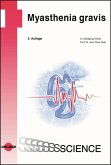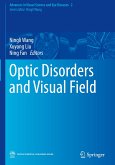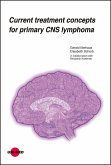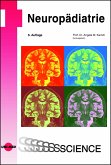Thomas Klopstock
Leber´s Hereditary Optic Neuropathy
Thomas Klopstock
Leber´s Hereditary Optic Neuropathy
- Gebundenes Buch
- Merkliste
- Auf die Merkliste
- Bewerten Bewerten
- Teilen
- Produkt teilen
- Produkterinnerung
- Produkterinnerung
Leber's Hereditary Optic Neuropathy (LHON) is, in many regards, the prototype among the mitochondrial disorders. In this book, international LHON experts provide a comprehensive, albeit condensed, overview of our current knowledge as well as open questions and future avenues in LHON research.
Andere Kunden interessierten sich auch für
![Myasthenia gravis Myasthenia gravis]() Wolfgang KöhlerMyasthenia gravis44,80 €
Wolfgang KöhlerMyasthenia gravis44,80 €![Moderne Praxis der Migränetherapie - bewährte Strategien und Innovationen Moderne Praxis der Migränetherapie - bewährte Strategien und Innovationen]() Christian MaihöfnerModerne Praxis der Migränetherapie - bewährte Strategien und Innovationen39,80 €
Christian MaihöfnerModerne Praxis der Migränetherapie - bewährte Strategien und Innovationen39,80 €![Systemische ATTR-Amyloidosen - Hereditäre Amyloidneuropathien und andere Organmanifestationen Systemische ATTR-Amyloidosen - Hereditäre Amyloidneuropathien und andere Organmanifestationen]() Claudia SommerSystemische ATTR-Amyloidosen - Hereditäre Amyloidneuropathien und andere Organmanifestationen4,95 €
Claudia SommerSystemische ATTR-Amyloidosen - Hereditäre Amyloidneuropathien und andere Organmanifestationen4,95 €![Optic Disorders and Visual Field Optic Disorders and Visual Field]() Optic Disorders and Visual Field104,99 €
Optic Disorders and Visual Field104,99 €![Current treatment concepts for primary CNS lymphoma Current treatment concepts for primary CNS lymphoma]() Gerald IllerhausCurrent treatment concepts for primary CNS lymphoma4,95 €
Gerald IllerhausCurrent treatment concepts for primary CNS lymphoma4,95 €![Neurometabolic Hereditary Diseases of Adults Neurometabolic Hereditary Diseases of Adults]() Neurometabolic Hereditary Diseases of Adults75,99 €
Neurometabolic Hereditary Diseases of Adults75,99 €![Neuropädiatrie Neuropädiatrie]() Neuropädiatrie118,00 €
Neuropädiatrie118,00 €-
-
-
Leber's Hereditary Optic Neuropathy (LHON) is, in many regards, the prototype among the mitochondrial disorders. In this book, international LHON experts provide a comprehensive, albeit condensed, overview of our current knowledge as well as open questions and future avenues in LHON research.
Produktdetails
- Produktdetails
- UNI-MED Science
- Verlag: UNI-MED, Bremen
- Seitenzahl: 88
- Erscheinungstermin: 17. September 2024
- Englisch
- Abmessung: 360mm x 286mm x 2mm
- Gewicht: 315g
- ISBN-13: 9783837416732
- ISBN-10: 3837416739
- Artikelnr.: 71747953
- Herstellerkennzeichnung
- Uni-Med Verlag AG
- Alten Eichen 2
- 28359 Bremen
- info@uni-med.de
- +494212041300
- UNI-MED Science
- Verlag: UNI-MED, Bremen
- Seitenzahl: 88
- Erscheinungstermin: 17. September 2024
- Englisch
- Abmessung: 360mm x 286mm x 2mm
- Gewicht: 315g
- ISBN-13: 9783837416732
- ISBN-10: 3837416739
- Artikelnr.: 71747953
- Herstellerkennzeichnung
- Uni-Med Verlag AG
- Alten Eichen 2
- 28359 Bremen
- info@uni-med.de
- +494212041300
1.History of Leber's Hereditary Optic Neuropathy (LHON)111.1.First descriptions and definition of the disorder111.2.Subsequent reports121.3.Genetics121.4.Environment131.5.Treatment141.6.A glimpse into the future142.Genetics of LHON182.1.Maternally inherited LHON and the role of mitochondrial DNA (mtDNA) pathogenic variants and haplotypes182.2.The new landscape of autosomal recessive LHON (arLHON)202.3.Interacting genetic variants in both mtDNA and nuclear genomes: the digenic model202.4.Questions that remain to be conclusively resolved213.Epidemiology283.1.Dependence on age and gender283.2.Penetrance and prevalence283.3.Genetic variation303.4.Association with other diseases304.Molecular background and pathophysiology of LHON334.1.From mtDNA mutations to complex I dysfunction334.2.Complex I dysfunction impacts cell physiology of retinal ganglion cells344.3.The specific vulnerability of RGCs and their axons355.Phenotypes of LHON395.1.Clinical course of adult-onset LHON395.1.1.Asymptomatic LHON405.1.2.Subacute stage of LHON415.1.3.Dynamic stage of LHON415.1.4.Chronic stage of LHON415.2.Atypical LHON425.2.1.Childhood onset LHON425.2.2.Late-onset LHON435.2.3.LHON plus and LHON-overlap syndromes435.2.4.Atypical clinical course436.Natural history of LHON456.1.Conversion456.2.Natural history of chronic LHON456.3.Spontaneous visual recovery496.4.Longterm sequelae546.5.Challenges547.Diagnostic pathway and differential diagnosis in LHON567.1.Symptoms and signs567.1.1.Visual acuity loss567.1.2.Visual field defect567.1.3.Fundus exam findings: optic disc hyperemia, microangiopathy and pseudoedema567.2.Diagnostic pathway: psychophysical findings, electrophysiological testing and retinal imaging587.2.1.Background587.2.2.Dyschromatopsia587.2.3.Pupillary light reflex and pupillometry597.2.4.Electrophysiological findings597.2.4.1.Pattern visual evoked potentials597.2.4.2.Pattern electroretinogram607.2.4.3.PhNR607.2.5.Retinal imaging607.2.5.1.Optical coherence tomography607.2.6.Optic disc perfusion - laser speckle flowgraphy (LSFG)627.3.Differential diagnosis of LHON627.3.1.Optic neuritis (ON) and other inflammatory disorders of the optic nerve627.3.2.Toxic and nutritional optic neuropathies627.3.3.Ischemic optic neuropathies637.3.4.Compressive optic neuropathies648.Special topic: autosomal recessive LHON (arLHON)678.1.DNAJC30-associated LHON678.1.1.Genetics678.1.2.Clinical phenotype688.2.NDUFS2-associated LHON708.2.1.Genetics708.2.2.Clinical phenotype709.Treatment rationale and approaches719.1.Natural history and disease staging719.2.Treatment rationale and therapeutic approaches729.3.Therapeutic window and current treatments7210.Idebenone treatment in LHON7610.1.What is idebenone?7610.2.Why idebenone is predestined to work in LHON7610.3.Preclinical studies7610.4.Clinical studies7710.5.Safety and efficacy of idebenone in LHON patients7810.6.Treatment effects in chronic LHON7811.Gene therapy8011.1.Overview of gene therapy8011.2.Development of gene therapy in LHON - Allotopic expression8011.3.Clinical trials of gene therapy in LHON8211.4.Gene therapy - Looking to the future84Index87
1.History of Leber's Hereditary Optic Neuropathy (LHON)111.1.First descriptions and definition of the disorder111.2.Subsequent reports121.3.Genetics121.4.Environment131.5.Treatment141.6.A glimpse into the future142.Genetics of LHON182.1.Maternally inherited LHON and the role of mitochondrial DNA (mtDNA) pathogenic variants and haplotypes182.2.The new landscape of autosomal recessive LHON (arLHON)202.3.Interacting genetic variants in both mtDNA and nuclear genomes: the digenic model202.4.Questions that remain to be conclusively resolved213.Epidemiology283.1.Dependence on age and gender283.2.Penetrance and prevalence283.3.Genetic variation303.4.Association with other diseases304.Molecular background and pathophysiology of LHON334.1.From mtDNA mutations to complex I dysfunction334.2.Complex I dysfunction impacts cell physiology of retinal ganglion cells344.3.The specific vulnerability of RGCs and their axons355.Phenotypes of LHON395.1.Clinical course of adult-onset LHON395.1.1.Asymptomatic LHON405.1.2.Subacute stage of LHON415.1.3.Dynamic stage of LHON415.1.4.Chronic stage of LHON415.2.Atypical LHON425.2.1.Childhood onset LHON425.2.2.Late-onset LHON435.2.3.LHON plus and LHON-overlap syndromes435.2.4.Atypical clinical course436.Natural history of LHON456.1.Conversion456.2.Natural history of chronic LHON456.3.Spontaneous visual recovery496.4.Longterm sequelae546.5.Challenges547.Diagnostic pathway and differential diagnosis in LHON567.1.Symptoms and signs567.1.1.Visual acuity loss567.1.2.Visual field defect567.1.3.Fundus exam findings: optic disc hyperemia, microangiopathy and pseudoedema567.2.Diagnostic pathway: psychophysical findings, electrophysiological testing and retinal imaging587.2.1.Background587.2.2.Dyschromatopsia587.2.3.Pupillary light reflex and pupillometry597.2.4.Electrophysiological findings597.2.4.1.Pattern visual evoked potentials597.2.4.2.Pattern electroretinogram607.2.4.3.PhNR607.2.5.Retinal imaging607.2.5.1.Optical coherence tomography607.2.6.Optic disc perfusion - laser speckle flowgraphy (LSFG)627.3.Differential diagnosis of LHON627.3.1.Optic neuritis (ON) and other inflammatory disorders of the optic nerve627.3.2.Toxic and nutritional optic neuropathies627.3.3.Ischemic optic neuropathies637.3.4.Compressive optic neuropathies648.Special topic: autosomal recessive LHON (arLHON)678.1.DNAJC30-associated LHON678.1.1.Genetics678.1.2.Clinical phenotype688.2.NDUFS2-associated LHON708.2.1.Genetics708.2.2.Clinical phenotype709.Treatment rationale and approaches719.1.Natural history and disease staging719.2.Treatment rationale and therapeutic approaches729.3.Therapeutic window and current treatments7210.Idebenone treatment in LHON7610.1.What is idebenone?7610.2.Why idebenone is predestined to work in LHON7610.3.Preclinical studies7610.4.Clinical studies7710.5.Safety and efficacy of idebenone in LHON patients7810.6.Treatment effects in chronic LHON7811.Gene therapy8011.1.Overview of gene therapy8011.2.Development of gene therapy in LHON - Allotopic expression8011.3.Clinical trials of gene therapy in LHON8211.4.Gene therapy - Looking to the future84Index87








